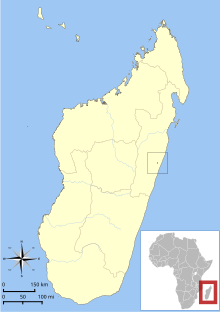| Gerp's mouse lemur | |
|---|---|

| |
| Scientific classification | |
| Domain: | Eukaryota |
| Kingdom: | Animalia |
| Phylum: | Chordata |
| Class: | Mammalia |
| Order: | Primates |
| Suborder: | Strepsirrhini |
| Family: | Cheirogaleidae |
| Genus: | Microcebus |
| Species: | M. gerpi
|
| Binomial name | |
| Microcebus gerpi Radespiel et al., 2012[3]
| |

| |
| Distribution of M. gerpi[1] | |
Gerp's mouse lemur (Microcebus gerpi) is a species of mouse lemur known only from the Sahafina Forest in eastern Madagascar, near Mantadia National Park. Its discovery was announced in 2012 by a German and Malagasy research team. The Sahafina Forest had not been studied until 2008 and 2009, when Groupe d'Étude et de Recherche sur les Primates de Madagascar (GERP)—a Malagasy-based research and conservation group for which the lemur is named—inventoried the forest's lemurs.
Based on genetic studies, measurements, and photos, the research team confirmed the Gerp's mouse lemur was an undescribed species, distinct from Goodman's mouse lemur, which is found 58-kilometre (36 mi) away. Gerp's mouse lemur is significantly larger, weighing on average 68-gram (2.4 oz), compared to Goodman's mouse lemur, which weighs about 44 g (1.6 oz). Jolly's mouse lemur, which is its closest relative and a neighbor to the south, is comparably larger, but differs in tail length and genetics.
Because it is a recently discovered species, little is known about its behavior, communication, ecology, or reproduction. The species appears to be restricted to a small region of lowland evergreen rain forest, and is seriously threatened by forest loss.
- ^ a b Andriaholinirina, N.; Baden, A.; Blanco, M.; Chikhi, L.; Cooke, A.; Davies, N.; Dolch, R.; Donati, G.; Ganzhorn, J.; Golden, C.; Groeneveld, L.F.; Hapke, A.; Irwin, M.; Johnson, S.; Kappeler, P.; King, T.; Lewis, R.; Louis, E.E.; Markolf, M.; Mass, V.; Mittermeier, R.A.; Nichols, R.; Patel, E.; Rabarivola, C.J.; Raharivololona, B.; Rajaobelina, S.; Rakotoarisoa, G.; Rakotomanga, B.; Rakotonanahary, J.; Rakotondrainibe, H.; Rakotondratsimba, G.; Rakotondratsimba, M.; Rakotonirina, L.; Ralainasolo, F.B.; Ralison, J.; Ramahaleo, T.; Ranaivoarisoa, J.F.; Randrianahaleo, S.I.; Randrianambinina, B.; Randrianarimanana, L.; Randrianasolo, H.; Randriatahina, G.; Rasamimananana, H.; Rasolofoharivelo, T.; Rasoloharijaona, S.; Ratelolahy, F.; Ratsimbazafy, J.; Ratsimbazafy, N.; Razafindraibe, H.; Razafindramanana, J.; Rowe, N.; Salmona, J.; Seiler, M.; Volampeno, S.; Wright, P.; Youssouf, J.; Zaonarivelo, J.; Zaramody, A. (2014). "Microcebus gerpi". IUCN Red List of Threatened Species. 2014: e.T16971461A16971464. doi:10.2305/IUCN.UK.2014-1.RLTS.T16971461A16971464.en. Retrieved 19 November 2021.
- ^ "Checklist of CITES Species". CITES. UNEP-WCMC. Retrieved 18 March 2015.
- ^ Cite error: The named reference
Radespielwas invoked but never defined (see the help page).
